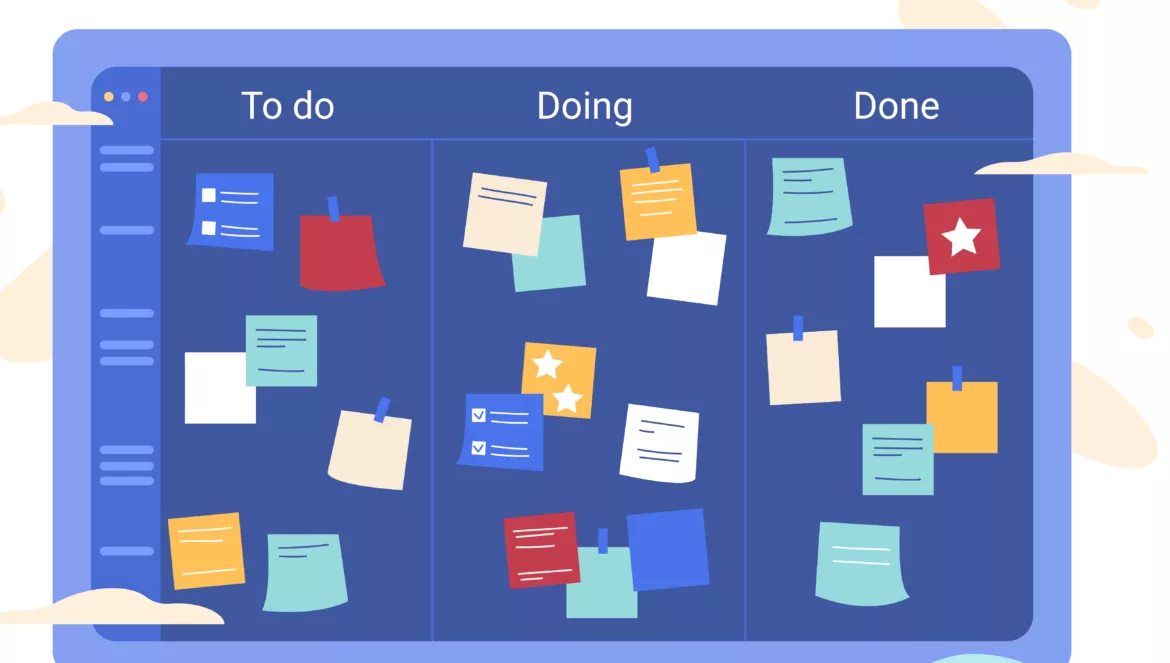Table of Contents
Agile classrooms function through the using kanban boards. These boards are typically separated into four columns; “Backlog,” “To Do,” “Doing,” and “Done.” These boards were created to make work visible and efficient in the workplace. In the classroom, they scaffold and teach students how to break down large tasks, prioritize work, make decisions as a group, and truly collaborate as a team.
Students working in self-selected teams learn the kanban system with scaffolding from the teacher. The board facilitates the learning of executive functioning skills keeping students organized and communicating while diving deeply into the content of the course.
Working in teams is typically met with a mixed bag of emotions for students. They often complain about pulling others through, unfair workload, confusion, and arguments. In their experience, teamwork means some kids slack, some kids work, and in most cases, it ends in a Hail Mary to the teacher’s desk. When the Kanban board is first taught, students remain skeptical, but the opportunity for hands-on learning and discovery soon changes their minds.
Introducing the Kanban Board
The first step is determining a definition of “Done.” Student teams work together to determine when work is considered done. The definition will differ for different teams. It should fit the team and the personalities within it.
The teacher can help prompt students to think about this definition by asking probing questions:
- If you know you tend to procrastinate, how you will address it?
- If you are detail-oriented, how can that benefit the team?
- How will you determine deadlines and, most importantly, stick to them?
These are the important discussions that need to occur before a project is launched. Our students all know each other. They have worked with each other in some way throughout their educational career. What could be better for them than to pull the skeletons of past projects out of the closet, address the elephants in the room, and set intentions based on the realities of their teams?
When the definition of done is complete, the real questions begin.
- Why were you asked to set a definition of “Done?”
- What is the purpose?
The definition of done ensures they have a team agreement about working together. It sets expectations about work to be handed in. It makes criticism less personal. Group standards are set, and they were created cooperatively. The negative feelings surrounding teamwork can begin to evolve.
The Mini-Lesson of Kanban Boards
Students are quickly briefed about the function of the Kanban board and what the categories mean. The backlog contains all work to be done and is broken down into increments. All work that can be planned will go into the backlog until it is ready to be worked on. The backlog can and will change because new information will be discovered along the way.
When a task is expected to be completed, it can move into “To Do.” This means to the teacher and the team that the task will be completed within the next increment of time.
The team moves the task to “Doing” when the task is underway. This signals that work is in motion on this task.
The task can finally be moved to “Done” when it meets the definition of Done.
Using Kanban Boards to Foster Hands-on Learning
Students then gather in teams with their rubrics, background information, criteria, and other project artifacts to start building their boards.
Instead of lecturing or planning their projects for them, the teacher steps back to the position of guide. They communicate, collaborate, and sometimes argue. They develop their social-emotional and executive functioning skills by using them in real situations. They color-code tasks, check against their rubrics and break down large assignments into doable tasks. They are in control while the teacher drifts between groups asking questions, offering praise, and answering questions.
Reflection On Kanban Board-Centered Learning
When work slows down, the teacher prompts a quick reflection discussion to evaluate the success of the setup.
- Why are we using Kanban?
- What is the purpose?
- Are there any benefits?
The benefits are obvious to the teacher and the students. Student teams cannot say they did not know a due date or that work is being done since it is being pulled across the board. They can see their work compared to other groups to determine if work is happening too fast or more likely to slow. They will all be on the same page, and work can be divided easily.
Building a backlog gives students insight into the work that must be done. By breaking down their project into small increments, they understand the scope of their project, and it will be easier to tackle.
The Kanban board brings transparency, communication, and collaboration to the work of learning. Students now have a visual representation of their work, which they can use to develop the AI-proof skills that will benefit them throughout their lives. The classroom will be more organized, the students will learn independently, and the teacher will be able to actively monitor learning without micromanaging each student. This is the benefit of Kanban in the classroom.



